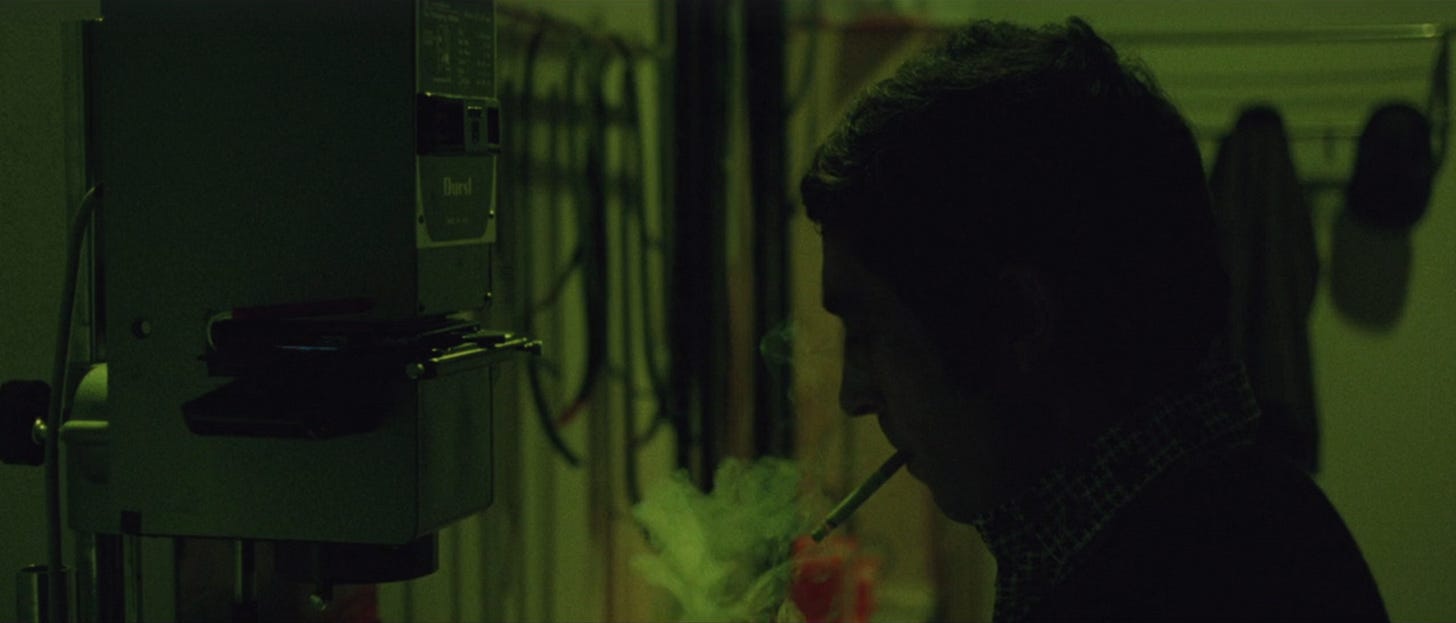Favorite First Watches of June
Five Films new to me this past month: from asteroids to zombie cops
The Cat O’Nine Tails / (1971) Dir. Dario Argento

Basically every 70s giallo film has a murder that goes down while a photograph is being developed in a dark room and it always looks sick. I’ve been on a massive giallo film kick as of late, as the microgenre favored by Italian directors of the 70s and 80s feels like it was designed in a lab specifically to appeal to me: beautiful women; sometimes beautiful men; international locales; artful murder, and gorgeous, pulsating color palettes, which give the proceedings a feeling of high drama and surreal danger. Long before Suspiria (1977), giallo maestro Dario Argento delivered this early slasher classic, about a reporter (the dashing James Franciscus) who enlists the assistance of a blind former detective (Karl Malden!) to solve a murder related to an experimental clinic, which is working to find a genetic source for criminality. Along the way, he encounters flighty heiresses, vibrant gay clubs, and a super-spooky crypt, all in the service of unraveling the mysterious case, which keeps claiming bodies. The “cat o’nine tails” refers to the fact that there are nine suspects to track down (which is, admittedly, a lot) in the service of the investigation. Gorgeously rendered and beautifully scored by Ennio Morricone, this stylish cult classic is a bit sillier than Argento’s usually fare, blending sly humorous beats that makes the film feel strikingly modern. Plus, it’s just fascinating to me that so many aging titans of the American mid-century thespian scene found a second wind in Italian genre cinema (I’m thinking in particular of Carroll Baker’s appearances in the giallo films of Umberto Lenzi): Karl Malden is legitimately terrific, as he always is, as the blind ex-detective too smart to be out of the game. The Cat O’Nine Tails is currently streaming on Tubi TV.
Asteroid City (2023) Dir. Wes Anderson

This honestly might be Jason Schwartzman’s best material since his last Wes Anderson collaboration, Rushmore (1998). “No, he ain't American. No, he ain't a creature of God's Earth, but he's a creature of somewhere.”
If anything, Asteroid City convinced me that Wes Anderson should be more alienating and retreat further into his obsessions. I wasn’t a fan of Anderson’s last omnibus film, The French Dispatch (2021), which felt empty and cold, an artifact of pre-pandemic life stuck out of time. Asteroid City is almost — even for all its caustic wit — warm: both in its striking oversaturated visual style and story of creative toil. Anderson isn’t a filmmaker whose works feel especially personal, even as he wears his interests and influences right on his sleeve, but this one feels particularly earnest: the offering of a man whose obsessive desire for control meets a cultural moment defined by chaos. The film tells the story of a play-within-a-play, Asteroid City, conceived by a lauded Southern author (Edward Norton) and televised, as plays of the era so often were, for audiences at home. The film flits between its black-and-white framing structure, which delves into the personalities behind the play, as well as the play itself, which unfolds on a deliberately artificial stage set, punctuated by fantastical, retrofuturist elements. The plays tells the story of a stargazer convention set in a small town in the American Southwest, which is site to a large crater from an asteroid crash (which houses a meteorite). As young geniuses gather at the town, we’re introduced to a roster of eclectic characters befitting Anderson’s go-to schtick, including standout performances from (a pitch-perfect Scarlet Johansson), Jeffrey Wright, and Tom Hanks (whose appearance as an “Anderson” actor is as unusual as it is perfect)…all of whom will soon be trapped in quarantine, due to circumstances beyond their control. I don’t think Jason Schwartzman has ever been given better material? It feels like coming home for the Rushmore (1998) leading man, whose been slumming it in side parts ever since. Aesthetically speaking, the film is a master class in traditional filmmaking, a sorely needed breath of fresh air after years of gray sludge and CGI sets. How can anyone begrudge Anderson’s eccentricities, when he’s one of the few filmmakers who refuses to surrender to the dehumanizing grind of the content factory? A love letter to the American Southwest and mid-century popular culture, the film is a gorgeous parody of unfettered Americana, with Anderson embracing the ridiculousness of his perfectionism (and his bone-dry sense of humor, which makes him a genius, but also alienates him). Asteroid City (2023) is now playing in theaters and coming to On Demand on Tuesday, July 11th.
Bloody Moon / Die Säge des Todes (1981) Dir. Jesús Franco
Exploitation film maestro Jesús (or “Jess”) Franco is the king of trash cinema, best known for horny lowbrow horror classics like Vampyros Lesbos (1971); A Virgin Among the Living Dead (1973); Venus in Furs (1969), and my personal favorite, Female Vampire (1975). His (best) films blend true eroticism with elements of staggering darkness, making them fascinating documents of late Francoist Spain, Franco’s native land (though he worked in Italian, French, and West German film markets as well) and blurring the lines between pornography and narrative cinema. This film, one of the director’s later works, is more of a straightforward horror film, but it has all the trademarks of the director’s signature pulp excellence style: beautiful women, unforgettable horror visuals, a stirring score, and an exotic locale (an international language school in Costa Del Sol, Spain, full of gorgeous young female co-eds, many of whom are wearing cowboy boots for some reason). It tells the story of a young woman (terrific scream queen Olivia Pascal) who finds herself at the center of a series of gruesome murders, as she hurries to unravel a case of incest, disfigurement, and scheming…before she becomes the next target! You can definitely see the budget restraints on this one, which manages some ok-to-cool practical effects, which include some dicey-looking doubles…but I was most impressed by its striking visual style, which takes an arthouse approach to slasher conventions (a truly upsetting, yet oddly beautiful, kill involving a bare breast, for example, had me cringing in sympathy). A film doesn’t need a big Hollywood budget to be beautiful: it just needs to have an artistic vision this deranged. Bloody Moon (1981) is currently streaming on Tubi TV.
Basket Case (1982) Dir. Frank Henenlotter
New York City is hell and who knows what oddities wait for us among its most anonymous spaces in cult horror filmmaker Frank Henenlotter’s low-budget creature feature (and directorial debut), Basket Case. Set at a disreputable hotel in the heart of pre-redeveloped Times Square, the film follows the story of a young traveler (Kevin Van Hentenryck), who carries (and talks to) a cardboard box, which he soon begins to feed regularly. What’s in the box and how it got there is the thrust of the film’s denouement, but things are much more complicated (and two dimensional) than they seem, as bodies begin to disappear (and disturbing noises keep emanating from the man’s hotel room). Along the way, he begins a touching friendship with a sex worker down the hall (a charismatic Beverly Bonner) and a fraught romance with a hospital receptionist (Terri Susan Smith), but he’s running on borrowed time as he attempts to forget what’s in the box (and what it means for the entire hotel, who are soon terrorized by its contents). Cutting between the hotel interior and on-location shots of Times Square at its sleaziest (and most honest), the film makes terrific use of the city’s dark corners and its illusions of anonymity, flooding the screen with its sleaziest elements. But it’s not the city that’s to blame for the carnage suddenly surrounding our protagonist: its the darkness he carries with him — and because it’s New York City, that becomes the business of everyone else. Basket Case (1982) is currently streaming on Tubi TV.
Maniac Cop (1988)
“Whole city's goin' to hell. You can't take a pee anywhere anymore.”
William Lustig’s Maniac (1980) is a classic of stylish genre film excellence, so I was excited to get eyes on his follow-up, Maniac Cop (1988), penned by B-film Maestro Larry Cohen, responsible for underrated classics like Black Caesar (1973), It's Alive (1974), and Q – The Winged Serpent (1982). The film is a magic act, stuffing ACAB-messaging into a near perfect, lean horror concept: a former cop, transformed and mutilated in prison after he’s incarcerated with all the men he locked up, returns to terrorize a city, killing people while in uniform. As a result, the citizens begin to blanket distrust the police, terrified that any cop might be the titular maniac cop. The film is ostensibly led by Tom Atkins — of genre classics like The Fog (1980) and Halloween III: Season of the Witch (1982) — a great paternal figure whose steady detective work leads him to the defense of Bruce Campbell, a philandering policeman who becomes the primary suspect for the maniac cop after his wife is found murdered. A Psycho-like switch happens midway through the movie, handing over the film to Campbell and his mistress/partner Laurene Landon, and the film really takes off in his far too capable (and handsome) hands. Campbell is terrific here: all brooding and bug-eyed reaction in the face of mounting horrors, looking (and acting) every bit like Cary Grant when he allowed himself to go “clown mode” — like in Sylvia Scarlett (1935) or Arsenic and Old Lace (1944). As the film explores his mistaken incarceration à la The Wrong Man (1956), it also slowly reveals the zombie cop, played (terrifyingly) by Robert Z'Dar, a character actor with a form of cherubism that granted him a notably enlarged jawline. This is one of the great examples of B films made on the streets of New York that use the depersonalizing scope and look of the city as a texture for its horror. Who do you trust when the people paid to protect you cannot be trusted? What do you do when murderers are protected within an armed force tasked with saving lives? Maniac Cop (1988) is currently streaming on Tubi TV.






